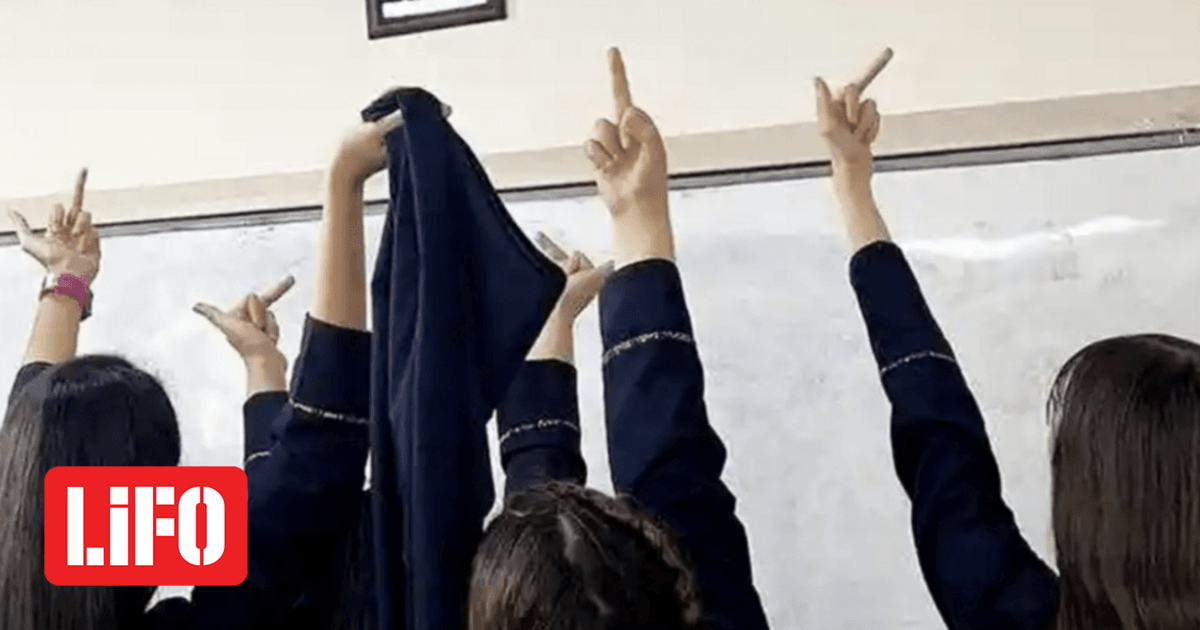
Iran continues to “boil”. The unjust death of Lahmasa Amini under mysterious circumstances has taken the country’s women to the streets as at least 92 people were killed in two weeks in anti-government protests. Now, “Fire” moves into the classroom as teenage girls take off their headscarves and pose for photos with their hair hanging down in a show of support, revolution and anger for their lost girlfriends.
Nika Sakarami, who lived in Tehran, would have turned 17 on Sunday, but was murdered in September. Her family found her body in the detention center mortuary ten days later. Minors of the country turn their backs to the lens and gestures, sometimes placing the victory sign, sometimes humiliating gestures in portraits of leaders, above the plates.
On Tuesday, President Ebrahim Raisi made a somewhat futile call for “unity against protests” as protests spread and intensified in some 45 Iranian cities, with citizens of different backgrounds and classes joining their voices.
Raisi repeated the government’s narrative that the wave of backlash was caused by “foreign agitators”. But he acknowledged that some Iranians resent the “flaws” of the Islamic Republic.
However, public outrage is so widespread that even a hard-line newspaper has openly challenged the authorities, accusing them of condoning their failures and anti-citizenship.
The editorial in the “Jomhouri Eslami” newspaper said: “No foreign enemies or internal opposition can push cities into a state of rebellion without the background of discontent.” “Denying this fact will not help.”
The protests continue two weeks later and pose the most serious challenge to Iran’s advanced religious leadership in more than a decade. Unlike previous protest movements, this one is led by women.
They initially erupted after the death of a young Kurdish woman who was taken into custody by morality police, and the name Mahsa Amini became a digital rallying cry.
But the protests have expanded into a broader demand for change, from a population frustrated with political controls, economic isolation and stagnation.
Security forces responded with live ammunition and violence, killing dozens and arresting more than 1,500.
Despite state violence, Iranians continued to go out and demonstrate in their streets, schools and offices, removing portraits of the two supreme leaders – Ayatollah Khomeini and Ayatollah Ali Khamenei.
In a video clip from a class, a girl replaced her photo with the slogan of the protest movement, and the photo spread on social networking sites. Meanwhile, another group of teenage girls was filmed making derogatory gestures towards the two men.

The demonstrators adopted the Kurdish fighters’ slogan: “Women. Zoe. Freedom.” In videos from across Iran, women walk and dance in the streets with their hair uncovered and their headscarves burned. And all this in a country that forbids women from dancing and singing in public. Which prevents them from showing even a patch of skin behind their face and their palms.
Where citizens cannot protest in open spaces, they organize demonstrations indoors and circumvent government repression online by uploading videos and photos.
Iranian authorities have a dark history of using lethal force against protesters, including in 2019 and 2009. As the movement swells and rulers in Tehran increasingly frustrated, Western governments are warning Khamenei against escalation.
US President Joe Biden said he was “deeply concerned about reports of an intensification of violent repression.” The US president added that Washington supported technological solutions that would allow Iranian citizens to evade their government’s control over the Internet. He also threatened “additional consequences” for anyone who uses violence against peaceful protesters.
France has pressured the European Union to “target senior officials and hold them to account,” the Associated Press reported. In the UK, the government summoned the Iranian ambassador and the foreign secretary, James Cleverly, described the levels of violence as “really appalling”.
The Iranian government tried to intimidate Iranian celebrities and journalists to silence their voices over the Internet and forcing ordinary citizens to return to their homes.
On Monday, students protested the mass arrests in Tehran, with a demonstration in the conservative city of Mashhad, saying that too many people had been arrested and that the country’s most notorious prison looked more like a university campus.
Sharif University turned into a prison! “Evin Prison has turned into a university,” they said. Sharif University became a battleground over the weekend, as security forces surrounded students who fired tear gas and arrested several of them.
School girls demonstrated in the streets without their headscarves, chanting “Women. Zoe. Freedom.” In the city of Karaj, west of the capital, and in the Kurdish city of Sanandaj. Footage of the protests spread widely on social media.
The scenes remind us of the days after the 1979 Islamic Revolution that brought the current government to power. Back then, as now, large numbers of women came out to protest against the compulsory veil, and high school girls played a major role, although the protests were eventually suppressed.
Dozens of Iranian journalists have been arrested in an apparent attempt to stop the news About the protests, the government attempted to block the internet and block access to major social media sites used to prepare for protests and share news.
The authorities also arrested a musician who played protest slogans and messages. Shirvin Hajipur’s sad song “For” became an unofficial anthem almost overnight. He was eventually released on bail.
“To my sister, to your sister, to our sisters,” she sings in the recording, acknowledging the critical role of women in leading the protests.

“Hipster-friendly coffee fanatic. Subtly charming bacon advocate. Friend of animals everywhere.”





More Stories
F-16 crashes in Ukraine – pilot dies due to his own error
Namibia plans to kill more than 700 wild animals to feed starving population
Endurance test for EU-Turkey relations and Ankara with Greece and Cyprus